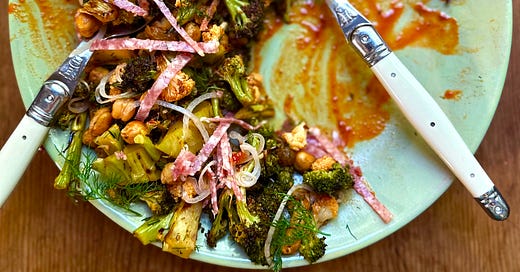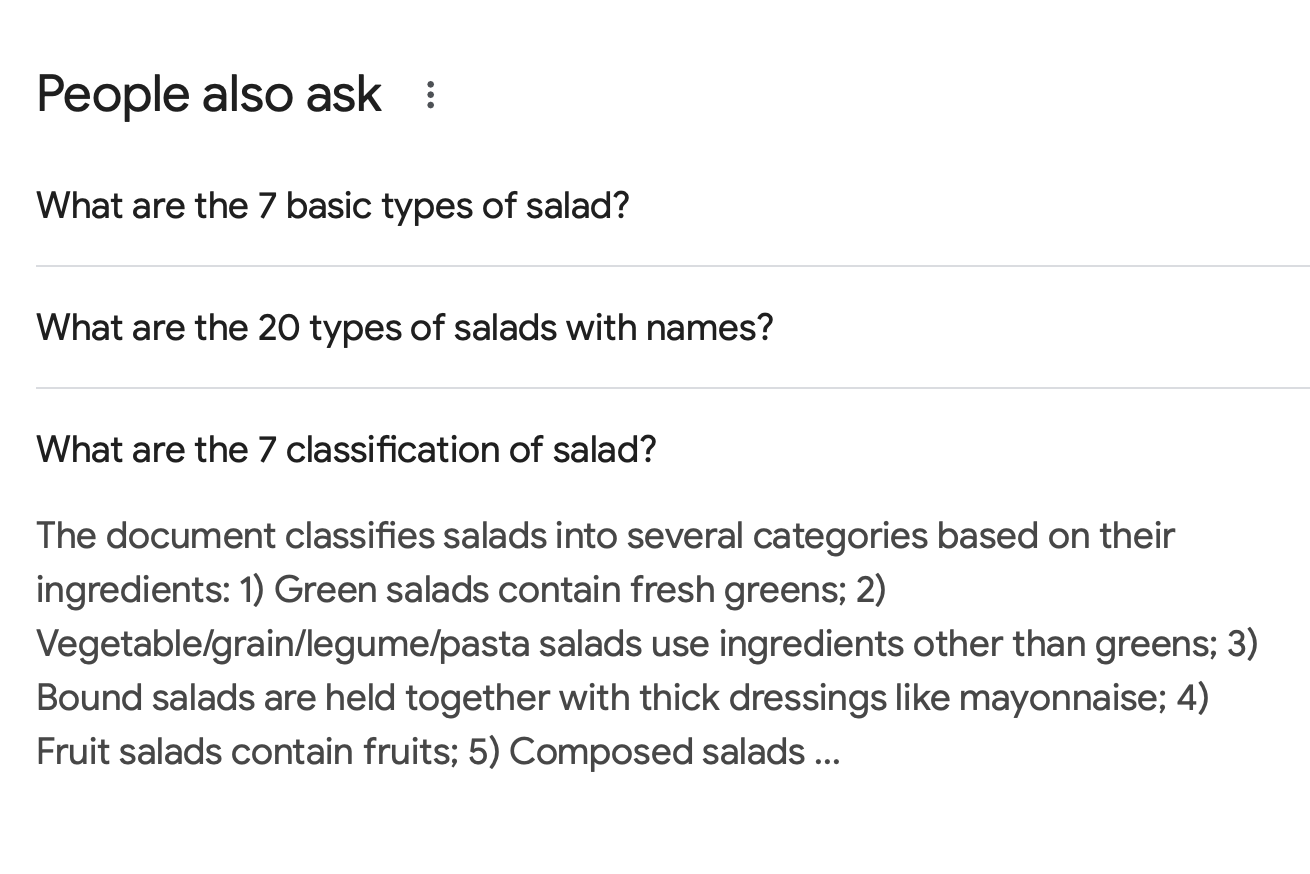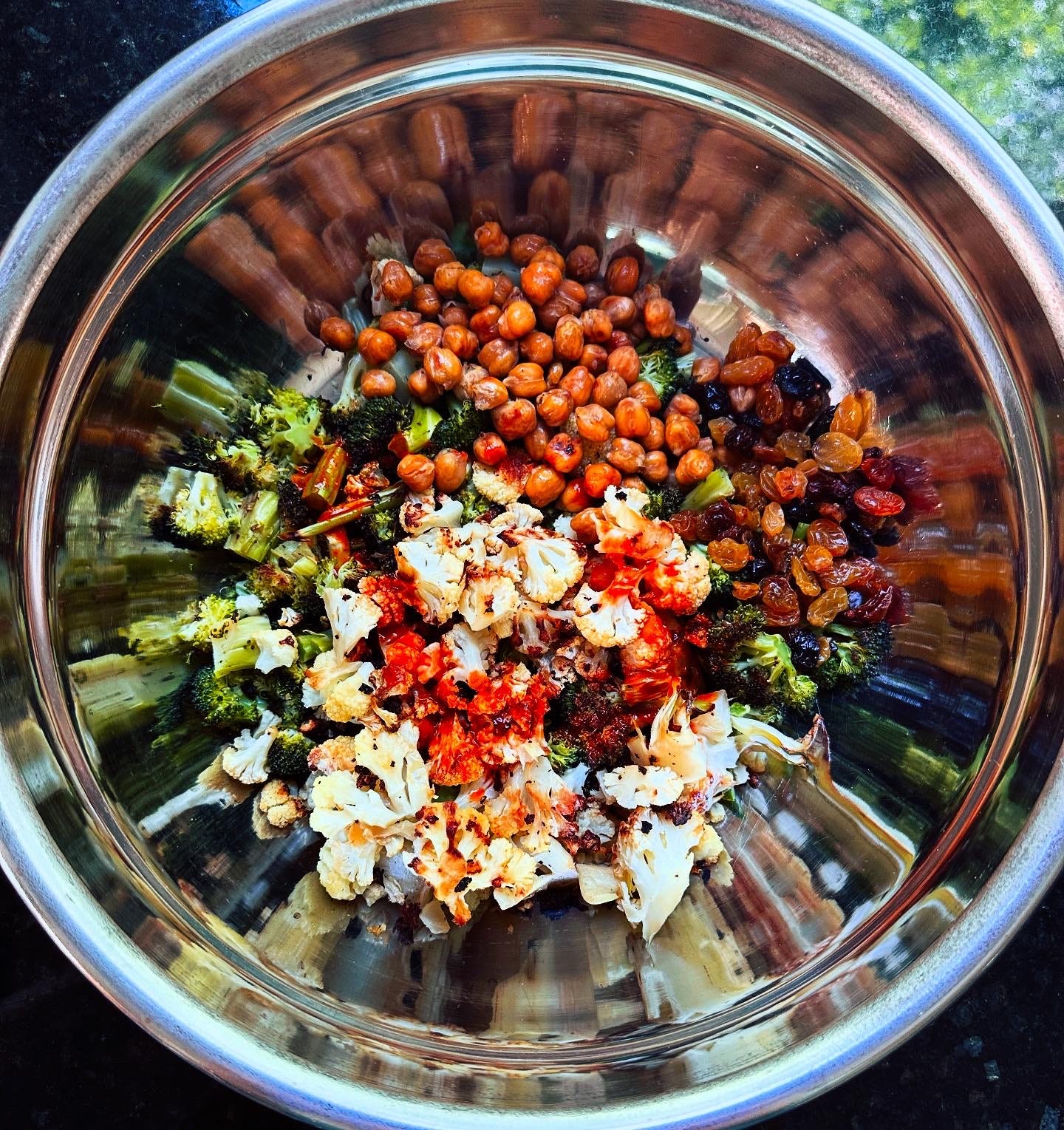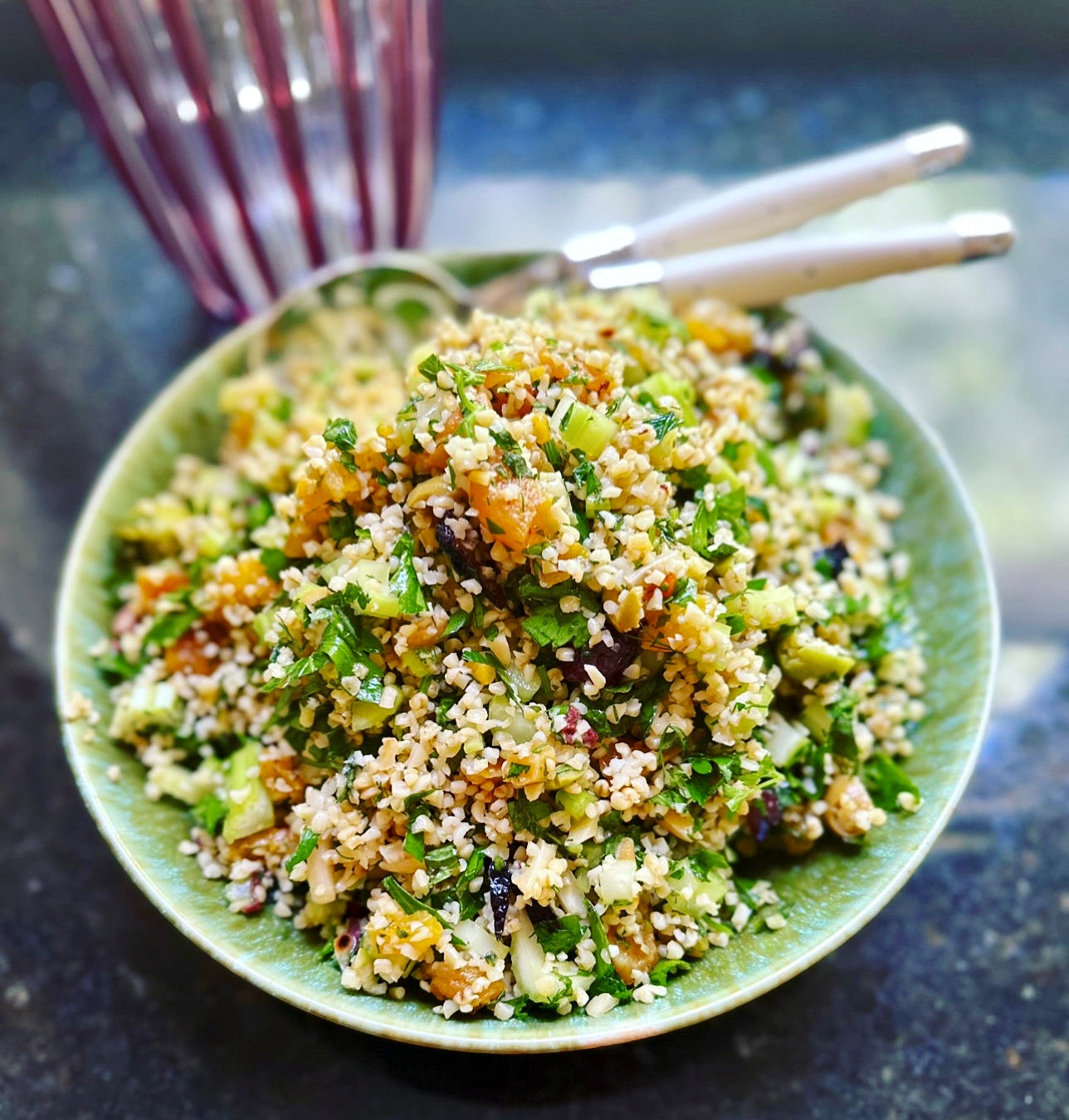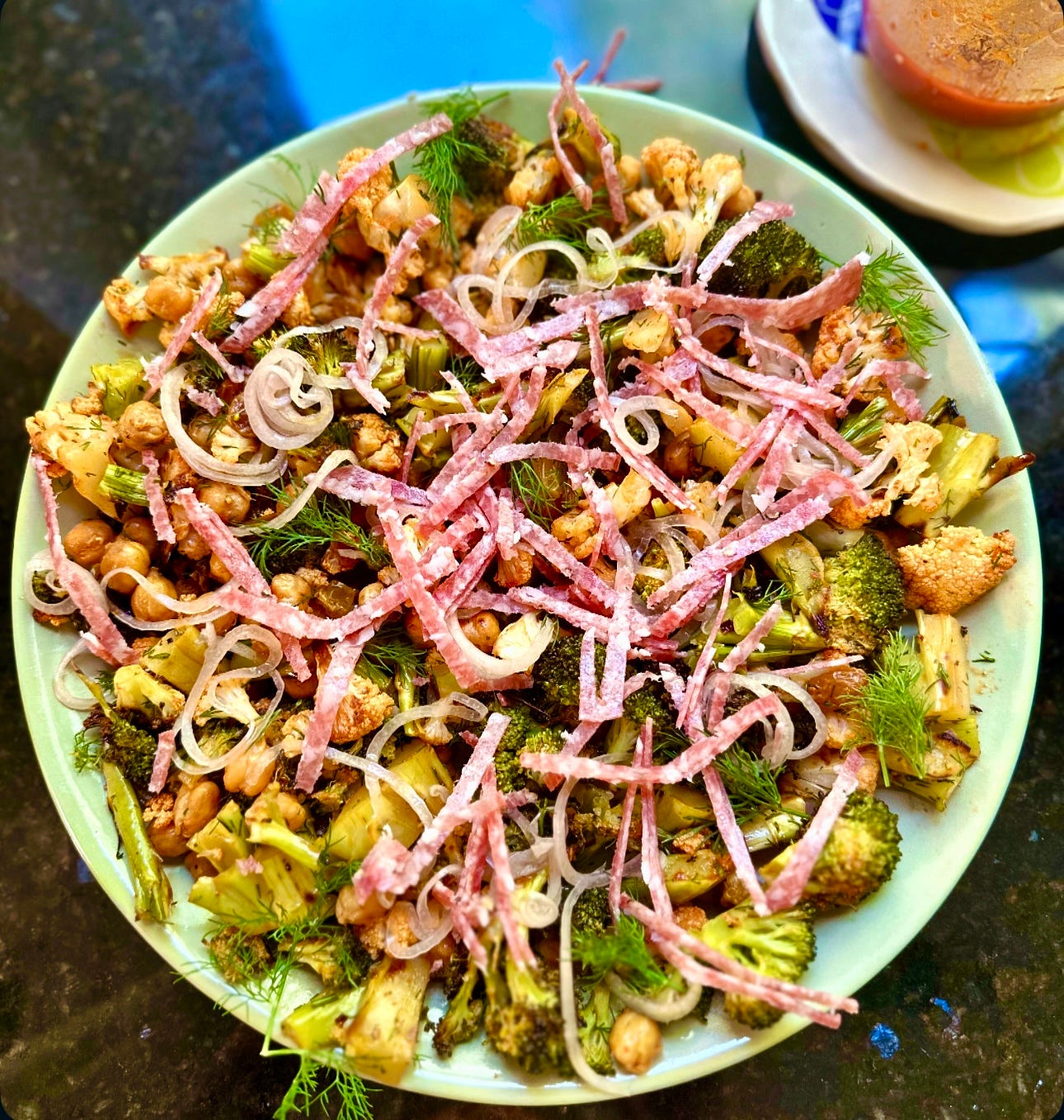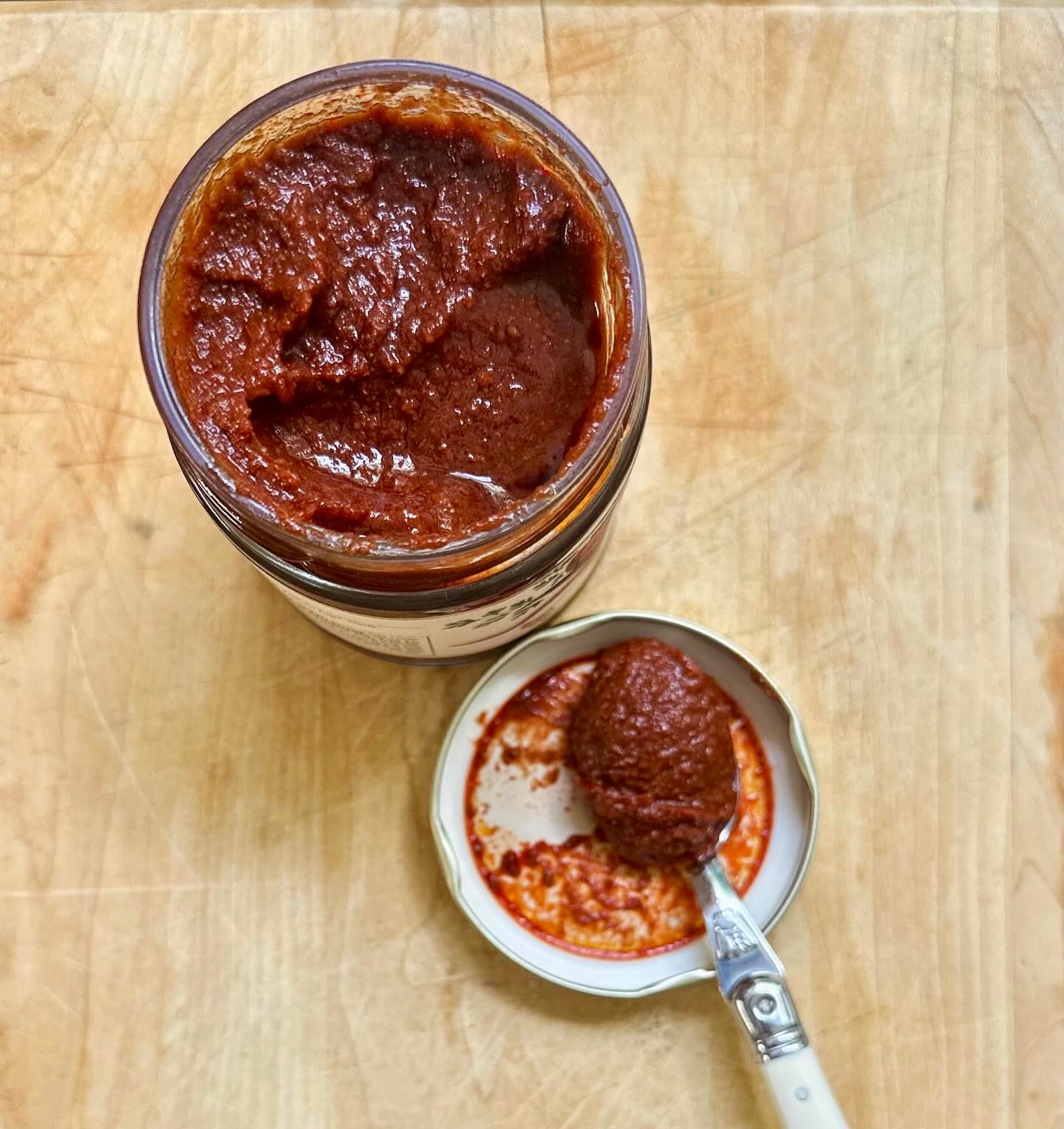Free Issue! Herby Bulgur with Olives and Apricots. Roasted Broccoli and Cauliflower w/ Harissa Dressing and Salami.
We don't send out many free issues—so this is an ICYMI!
IF THE DEPARTMENT OF SALAD EVER OWNS and operates a restaurant, we’ll serve nothing but salads, of course. But it would be an upscale sit-down restaurant, where salad was honored and elevated, rather than one of those fancy-ish fast-food salad spots, which we used to love but which we recently cooled on, thanks to the insane prices and the fact that we found a clump of frozen shrimp in one and a stray romaine core in another. I don’t know how they’ll win us back.
But you know what we would not do? Divide the menu into Entree Salads and Side Salads, or Green Salads and Grain Salads, or Fruit Salads and Vegetable Salads, or Dinner Salads and Lunch Salads, or Summer Salads and Fall, Winter, and Spring Salads. Never mind Composed, Gelatin, Pasta, Legume, and Bounds Salads (whatever those are).

They’re all just salads to us, and equal in the eyes of God, or—if you’re a pagan—in the eyes of Min, the Egyptian god of lettuce. But, again, you don’t need lettuce to make a salad.
And since you absolutely can’t pin salad down, our advice would be to just stop trying. Surrender to its ineffability. To this end, we might even make the menu of our imaginary salad restaurant an actual kaleidoscope, which you pick up and gaze into as an ever shifting, ever evolving, slightly confusing array of salady dishes appears and disappears. That is the nature of salad.

We simply have no desire to contribute to the infinite network of imaginary fences mankind insists on building, as a way to categorize and classify and group everyone and everything, in order to make it clear where we stand in relation to everything and everyone else in the universe. It’s okay to let go of the rigidity of false constructs, anywhere and everywhere you may find them. Smash them!
But we’d be happy if people on the internet (or robots or chimpanzees with keyboards— whomever it is) just stopped asking questions like the ones below. (Is there a salad entrance exam we don’t know about? And aren’t there much more important questions at this stage of our “civilization”?)
Lately, I’ve been thinking that the categories that bother me most in the salad cosmos are the Entree vs. Side categories. “Side” can be such an ugly word, partly because it’s so subjective. It’s a side salad to/for whom?
DID YOU KNOW? It takes two kinds of lettuce (🥬 + $$) to keep the Department of Salad alive. The best way to support us, if you don’t already: Press the green button (and get full access to all the salad in our enormous archive).
But since I am openly a giant pill and a hypocrite, I don’t mind revealing that right as I was rehashing all my petty complaints about the human insistence upon creating a taxonomy of all the matter, spirit, and beliefs in existence, I was simultaneously building my own little fences around the salads that I have for you today. (And I realized once again that I am the worst and that I am very lucky I don’t actually have to live by my own rules.)
For both of them, I was thinking in terms of dishes that you might bring to a cookout or a picnic to serve alongside cookout fare—basically side salads. Which they can easily be.
But it took until I’d eaten nothing but an enormous amount of the bulgur salad for supper one night and then devoured the harissa roasted vegetable one for breakfast, lunch, dinner, and snacks another day to remember what the boys in the lab and I always say: What’s a side salad? Half an entree salad. And: Any salad can be an entree salad, as long as you eat enough of it.
Both of these are those kinds of salads. So if you do take them to a cookout or a potluck or a picnic, you might want to double the recipes so you’ll also have some at home. (Both are delicious as leftovers.)
🍅 🥕 🥬 🌿
ONE little REQUEST BEFORE YOU HIT THE RECIPES?
Would you mind hitting the ❤️ button at the top left or bottom left of this newsletter if you enjoy being here? It puts the git in our gittyup. Also, we’d LOVE it if you felt like sharing the newsletter with a friend; just use the button below. XO—Emily
🍅 🥕 🥬 🌿
*RECIPE: Herby Bulgur Salad with Olives and Apricots
Serves 4 to 6
This salad is made from a certain kind of leftover—the kind you get when you regularly buy too many random herbs because they are pretty, or every kind of olive you see, or just about any dried fruit (which never seems to disappear), or celery (which I’m convinced reproduces in my crisper). Fortunately, it rewards you with the most splendid traditional leftovers. If you’re making this salad the day ahead or to serve at a cookout or bring to a potluck, wait to add the nuts until you’re ready to go.
8 ounces (1 heaping cup) medium bulgur
1⅓ cup boiling water
¼ cup olive oil
Juice of 1½ large lemons (6 to 7 tablespoons), plus extra for finishing
2 cloves garlic, grated
1 tablespoon honey, plus extra for finishing
½ teaspoon kosher salt
2 cups finely chopped soft herbs (I used a lot of basil and parsley, along with mint and dill, and a small amount of tarragon)
1 cup mixed pitted olives, roughly chopped (I used Kalamata, Castelvetrano, and the pimento-stuffed Manzanillas often referred to as “salad olives”; if you have oil-cured on hand, I’d only use a few since they tend to bully all the other flavors here)
1 heaping cup chopped dried apricots
1 ½ cups diced celery
⅓ to ½ cup toasted slivered almonds, roughly chopped (you could use any almonds have, as long as you toast them)
Place the bulgur in a large bowl and pour the hot water over it. Give it a stir, cover, and let sit until just tender, about 20 minutes. All the water should be absorbed by this time. If not, drain it. Allow to cool uncovered.
Meanwhile, combine the olive oil, lemon juice, garlic, honey, and salt in a jar with a tight-fitting lid; shake vigorously to mix and dissolve honey; pour over the cooled bulgur, stirring to combine. Transfer to a covered container and refrigerate until completely chilled—or overnight.
When ready to serve, add the herbs, olives, apricots, and celery and toss gently to combine. Taste. If it “needs something,” mix 1 tablespoon of the extra honey with the juice of half a lemon; drizzle this over the salad and toss again. Adjust salt and pepper and serve.
*RECIPE: Chopped Roasted Veg Salad with Potent Harissa Citrus Vinaigrette
Serves 4 or so
I have no science to back it up, but I believe that roasting the broccoli and cauliflower in thick slices, or “steaks,” before chopping produces a texture superior to roasting florets: tender but firm with crisp bits. But if you’d like to instead break your cruciferous vegetables into florets before roasting, feel free—just slice them in half so they have a flat side for browning.
I am thrilled by how delicious salami and dill are together. For the record, I used less salami for the photo—just so you could see the rest of the salad. When testing and tasting it, I really piled it on. Regarding the golden raisins: don’t leave them out, and don’t bother to plump them. They’re perfect when slightly chewy here and they eventually get plump if they reach the leftover stage: both are good.
1 pound (about 2 small crowns) broccoli
½ small cauliflower
1½ cups cooked chickpeas, drained and patted dry
4 or 5 tablespoons olive oil, divided
½ cup golden raisins
½ cup loosely packed chopped dill, plus a small handful of fronds for garnish
Potent Harissa Citrus Vinaigrette (method below)
Quick Pickled Shallots (method below)
Shredded salami (I used Genoa, but hard salami would be good; stack the rounds then slice thinly), as much as you want; I like a ton
Salt and freshly ground black pepper
Preheat oven to 425°F (218°C)
Roast the vegetables. Place the broccoli and the cauliflower stem-side down and cut them into thick slices or “steaks.” (See photos, above). Arrange in a single layer on lined sheet pans (you might have to do this in batches). Drizzle each pan with about 1 tablespoon (or even less—no need to soak them) of the olive oil, using your fingers to make sure the vegetables get an even coating. Season with salt and pepper and roast, turning once, until tender but still a bit firm and browning in spots, about 20 minutes. Once cool, chop the vegetables and set aside.
Roast the chickpeas. Place the dried chickpeas on a lined sheet pan; drizzle with a tablespoon of the olive oil, season with ½ teaspoon kosher salt and several turns of black pepper, and roast for about 20 minutes, giving them a stir about halfway through. Set aside to cool.
In a large bowl, combine the broccoli, cauliflower, and chickpeas (along with any crispy bits from the pans) with the golden raisins and chopped dill. Drizzle with several tablespoons of the dressing and toss gently. Taste for more dressing (I like a lot); adjust salt and pepper. When ready to serve, transfer the mixture to a serving platter or shallow bowl and top with as many pickled shallots as you’d like and a generous amount of shredded salami. Garnish with the extra dill fronds; bring to the table with any remaining dressing on the side.
Potent Harissa Citrus Vinaigrette
In a jar with a tight-fitting lid, combine all ingredients and shake vigorously to combine; remember you want the honey to dissolve. Taste and adjust; you might want more olive oil or a little more honey.
2 tablespoons harissa paste (not sauce); I like New York Shuk brand
2 tablespoons olive oil
3 tablespoons lemon juice
Zest of ½ lemon
1 tablespoon white balsamic vinegar; if you need to use regular white wine vinegar, you might want to add a bit more honey
1 teaspoon honey
Pinch of salt
Quick Pickled Shallots
1 large shallot, very thinly sliced
¼ cup rice vinegar
¼ teaspoon sugar
¼ teaspoon salt
Heat the vinegar in a saucepan until it begins to bubble, then stir in the sugar and salt until dissolved. Place the shallot in a wire meshed strainer over a small bowl. Slowly pour the hot vinegar mixture over the shallot, reserving the vinegar. Repeat with the vinegar from the bowl. Place the par-blanched shallot in a jar with the remaining vinegar mixture and refrigerate until very cold.
🥬🥬🥬That’s It! We’re done here! We’ll see you soon with a recipe for authentic Icelandic súrsaðir hrútspungar. I’m kidding—it’s going to be salad.
🥬🥬 ONE MORE THING: Please remember that while you may receive The Department of Salad as an e-mail, all issues of the newsletter—along with any corrections, the archive, and our Fancy New Recipe Index—are always available at the Department of Salad website. (You can always search “The Department of Salad” or go directly to emilyrnunn.substack.com.) All the recipes from all the newsletters will be there for you. To search the Index, simply use the search function (command F) that produces a search bar in the upper-right-hand corner of the page.
🥬 IN THE MEANTIME: If you feel like sharing the Department of Salad with friends or family who deserve it, please do so with the buttons below. It would mean the world to us! And thank you, always, for being a special subscriber.

